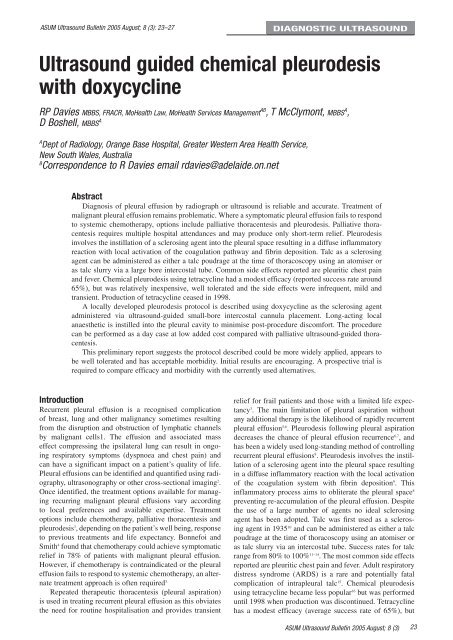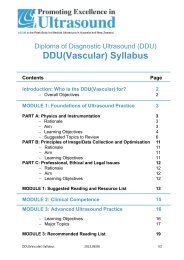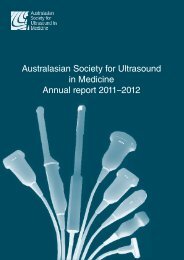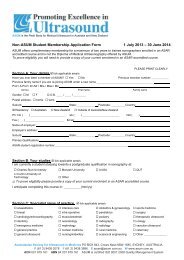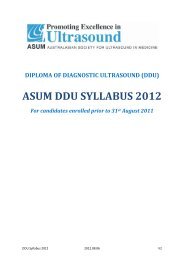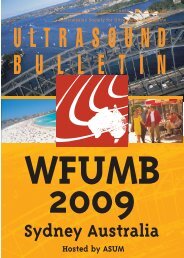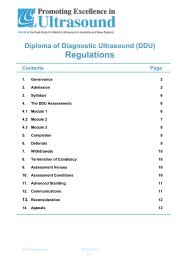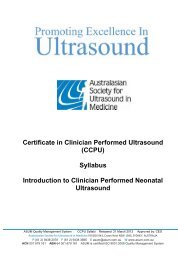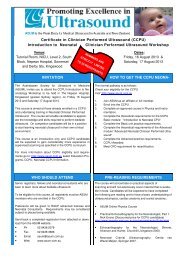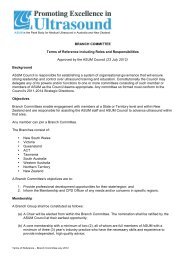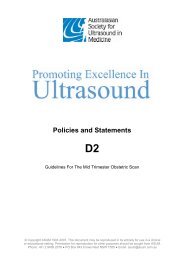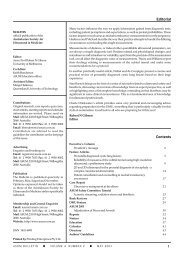Volume 8 Issue 3 - Australasian Society for Ultrasound in Medicine
Volume 8 Issue 3 - Australasian Society for Ultrasound in Medicine
Volume 8 Issue 3 - Australasian Society for Ultrasound in Medicine
You also want an ePaper? Increase the reach of your titles
YUMPU automatically turns print PDFs into web optimized ePapers that Google loves.
ASUM <strong>Ultrasound</strong> Bullet<strong>in</strong> 2005 August; 8 (3): 23–27DIAGNOSTIC ULTRASOUND<strong>Ultrasound</strong> guided chemical pleurodesiswith doxycycl<strong>in</strong>eRP Davies MBBS, FRACR, MoHealth Law, MoHealth Services Management AB , T McClymont, MBBS A ,D Boshell, MBBS AADept of Radiology, Orange Base Hospital, Greater Western Area Health Service,New South Wales, AustraliaBCorrespondence to R Davies email rdavies@adelaide.on.netAbstractDiagnosis of pleural effusion by radiograph or ultrasound is reliable and accurate. Treatment ofmalignant pleural effusion rema<strong>in</strong>s problematic. Where a symptomatic pleural effusion fails to respondto systemic chemotherapy, options <strong>in</strong>clude palliative thoracentesis and pleurodesis. Palliative thoracentesisrequires multiple hospital attendances and may produce only short-term relief. Pleurodesis<strong>in</strong>volves the <strong>in</strong>stillation of a scleros<strong>in</strong>g agent <strong>in</strong>to the pleural space result<strong>in</strong>g <strong>in</strong> a diffuse <strong>in</strong>flammatoryreaction with local activation of the coagulation pathway and fibr<strong>in</strong> deposition. Talc as a scleros<strong>in</strong>gagent can be adm<strong>in</strong>istered as either a talc poudrage at the time of thoracoscopy us<strong>in</strong>g an atomiser oras talc slurry via a large bore <strong>in</strong>tercostal tube. Common side effects reported are pleuritic chest pa<strong>in</strong>and fever. Chemical pleurodesis us<strong>in</strong>g tetracycl<strong>in</strong>e had a modest efficacy (reported success rate around65%), but was relatively <strong>in</strong>expensive, well tolerated and the side effects were <strong>in</strong>frequent, mild andtransient. Production of tetracycl<strong>in</strong>e ceased <strong>in</strong> 1998.A locally developed pleurodesis protocol is described us<strong>in</strong>g doxycycl<strong>in</strong>e as the scleros<strong>in</strong>g agentadm<strong>in</strong>istered via ultrasound-guided small-bore <strong>in</strong>tercostal cannula placement. Long-act<strong>in</strong>g localanaesthetic is <strong>in</strong>stilled <strong>in</strong>to the pleural cavity to m<strong>in</strong>imise post-procedure discom<strong>for</strong>t. The procedurecan be per<strong>for</strong>med as a day case at low added cost compared with palliative ultrasound-guided thoracentesis.This prelim<strong>in</strong>ary report suggests the protocol described could be more widely applied, appears tobe well tolerated and has acceptable morbidity. Initial results are encourag<strong>in</strong>g. A prospective trial isrequired to compare efficacy and morbidity with the currently used alternatives.IntroductionRecurrent pleural effusion is a recognised complicationof breast, lung and other malignancy sometimes result<strong>in</strong>gfrom the disruption and obstruction of lymphatic channelsby malignant cells1. The effusion and associated masseffect compress<strong>in</strong>g the ipsilateral lung can result <strong>in</strong> ongo<strong>in</strong>grespiratory symptoms (dyspnoea and chest pa<strong>in</strong>) andcan have a significant impact on a patient’s quality of life.Pleural effusions can be identified and quantified us<strong>in</strong>g radiography,ultrasonography or other cross-sectional imag<strong>in</strong>g 2 .Once identified, the treatment options available <strong>for</strong> manag<strong>in</strong>grecurr<strong>in</strong>g malignant pleural effusions vary accord<strong>in</strong>gto local preferences and available expertise. Treatmentoptions <strong>in</strong>clude chemotherapy, palliative thoracentesis andpleurodesis 3 , depend<strong>in</strong>g on the patient’s well be<strong>in</strong>g, responseto previous treatments and life expectancy. Bonnefoi andSmith 4 found that chemotherapy could achieve symptomaticrelief <strong>in</strong> 78% of patients with malignant pleural effusion.However, if chemotherapy is contra<strong>in</strong>dicated or the pleuraleffusion fails to respond to systemic chemotherapy, an alternatetreatment approach is often required 3.Repeated therapeutic thoracentesis (pleural aspiration)is used <strong>in</strong> treat<strong>in</strong>g recurrent pleural effusion as this obviatesthe need <strong>for</strong> rout<strong>in</strong>e hospitalisation and provides transientrelief <strong>for</strong> frail patients and those with a limited life expectancy3 . The ma<strong>in</strong> limitation of pleural aspiration withoutany additional therapy is the likelihood of rapidly recurrentpleural effusion 5,6 . Pleurodesis follow<strong>in</strong>g pleural aspirationdecreases the chance of pleural effusion recurrence 6,7 , andhas been a widely used long-stand<strong>in</strong>g method of controll<strong>in</strong>grecurrent pleural effusions 8 . Pleurodesis <strong>in</strong>volves the <strong>in</strong>stillationof a scleros<strong>in</strong>g agent <strong>in</strong>to the pleural space result<strong>in</strong>g<strong>in</strong> a diffuse <strong>in</strong>flammatory reaction with the local activationof the coagulation system with fibr<strong>in</strong> deposition 9 . This<strong>in</strong>flammatory process aims to obliterate the pleural space 8prevent<strong>in</strong>g re-accumulation of the pleural effusion. Despitethe use of a large number of agents no ideal scleros<strong>in</strong>gagent has been adopted. Talc was first used as a scleros<strong>in</strong>gagent <strong>in</strong> 1935 10 and can be adm<strong>in</strong>istered as either a talcpoudrage at the time of thoracoscopy us<strong>in</strong>g an atomiser oras talc slurry via an <strong>in</strong>tercostal tube. Success rates <strong>for</strong> talcrange from 80% to 100% 11–14 . The most common side effectsreported are pleuritic chest pa<strong>in</strong> and fever. Adult respiratorydistress syndrome (ARDS) is a rare and potentially fatalcomplication of <strong>in</strong>trapleural talc 15 . Chemical pleurodesisus<strong>in</strong>g tetracycl<strong>in</strong>e became less popular 16 but was per<strong>for</strong>meduntil 1998 when production was discont<strong>in</strong>ued. Tetracycl<strong>in</strong>ehas a modest efficacy (average success rate of 65%), butASUM <strong>Ultrasound</strong> Bullet<strong>in</strong> 2005 August; 8 (3)23


